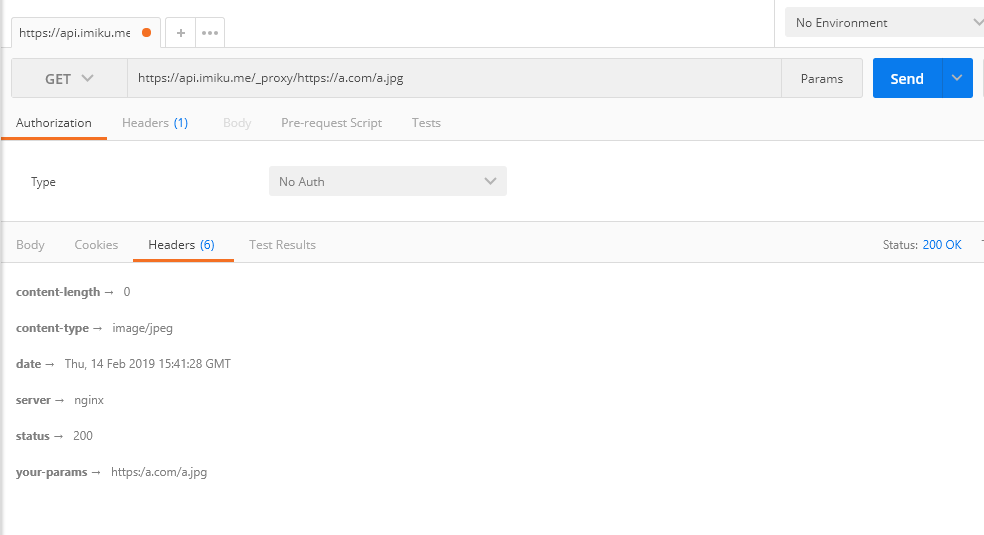
location ~* ^/_proxy/(.*)$ {
return 200;
add_header Your-Params $1;
} I passed the parameter https://a.com/a.jpg, but returned https:/a.com/a.jpg , and the slash became one, which is why

location ~* ^/_proxy/(.*)$ {
return 200;
add_header Your-Params $1;
} I passed the parameter https://a.com/a.jpg, but returned https:/a.com/a.jpg , and the slash became one, which is why
have you noticed that your address is a complete address, and nginx will normalize the path before parsing it. Explain here when to normalize
the so-called normalization is to decode the encoded characters in URI in the form of "% XX", and then parse the relative path in URI. " And ".." In addition, two or more adjacent slashes may be compressed into one slash.
example: if REQUEST_URI is / / trip/t.php, the normalized value will be stored in $request_uri for / trip/t.php,Nginx, while the normalized value will be stored in $uri. Ps where $request_uri and $uri are Nginx embedded variables.
do you understand? I passed the parameter https://a.com/a.jpg, but returned https:/a.com/a.jpg . The reason why the slash becomes one is because nginx normalizes the url format.
ps: I do java. In fact, this problem of url standardization is also explained in the official documents of spring security. If the English is good, you can take a look at the original text, https://docs.spring.io/spring...
.the spring security component directly throws a 500th exception in response to the existence / / situation of url, because this does not conform to the url specification, and nginx normalizes it
Previous: Add and change updates to vue array
sincerely ask for advice: < hr > I want to use node as the background to build a video streaming server. The front end is similar to Youku VOD. It can record the playback node function, and load the progress bar at any point (starting from the c...
external network access domain name: https: api.baidu.com internal network domain name: http: local.baidu.com this domain name is inaccessible outside the network! It is 127.0.0.1 pointed to by a private network address. I use nginx reverse proxy ...
Baidu said that there is a problem with the verification method in the file var lib pgsql 9.5 data pg_hba.conf, but the reason for changing the verification method is to use the command psql-U postgres-d mydjango-p 5432-h 127.0.0.1 to log in directl...
prompt as follows: Starting nginx: nginx: [emerg] "server " directive is not allowed here in etc nginx nginx.conf:17 what is the reason for this? How to solve it? ...
there is a problem when using nginx to configure the front and back end to separate items. The front end is done with react and the routing is in history mode. The nginx configuration is as follows: server { listen 8000; server_name test; ...
in order to obtain Tencent Cloud s ssl certificate, enter the URL domain name after modifying the non-Wanwang domain name registered by Aliyun. the website cannot be accessed. Has anyone encountered ? nginx is normal: [root@iZwz9hbv3lrr68d8bo5dvp...
I installed lnmp, under linux. I created a new ci project (ci framework). The directory is usr local nginx html ci, as shown in the following figure: ;http: localhost ci hosts127.0.0.1 www.test.comnginx.confserver_name www.test.com nginx.conf:...
safari: reference article nginx configuration ...
recently, a web project uses Baidu Maps, which requires nginx to represent Baidu Maps on servers with networks. When there is no external network and intranet, Baidu Maps can be displayed. Have any bosses ever made similar requirements? Please help! ...
Software version: centos 7 naxsi-0.55.3 tengine-2.2.2 nginx.conf file configuration, refer to official website document configuration, SecRulesEnabled; LearningMode; DeniedUrl " 403.html"; CheckRule "$SQL >= 8" BLOCK; Check...
the company uses a mall framework to access the environment on IWebShop online. The route is: http: 10.1.4.41 coupons binding id 4 is in the above format, but locally built can only be accessed through the following routes http: 10.1.4.41 ?controll...
windows system phpstudy integrated environment, nginx service, after the installation of laravel, except the home page can be accessed, the registration and login pages after make:auth can not be accessed. To find the reason on the Internet, just write ...
configure nginx.conf after applying for ssl certificate in normal order code is as follows: there are no errors in the nginx log. There is no problem for https to access other files. It is only prompted to access the php file 502. Excuse me, where ...
nginx main configuration: server { listen 80; server_name www.xxx.cn; -sharpcharset koi8-r; -sharpaccess_log logs host.access.log main; location admin { root app server; try_files $uri $uri adm...
the project is built online through: http: 10.1.4.41 coupons binding id 4 this kind of URL is used to access it, but after it is built locally, it can only be accessed through: http: 10.1.4.41 ?controller=coupons&action=binding&id=4 to ac...
For the project of django, direct command to run at 0.0.0.0 9090 is OK nginx reverse proxy is used to access static resources of 127.0.0.1purl 9090. my configuration is like this location { proxy_pass http: 127.0.0.1:9090;...
Server: Aliyun, lnmp1.4 version (centos7+nginx+mysql+php) recently updated the static file of the website with ftp, found that after overwriting the old picture with the new picture, the foreground still displays the old picture, then deletes the pict...
Today, I downloaded version 1.12.6 of docker, via yum using Ali CVM, and then downloaded a nginx image using docker. there is no problem at this time, but when you use docker run to create a nginx container, you will disconnect the Xshell remote conne...
this is an online tutorial, set up or no effect location = favicon.ico { log_not_found off; access_log off; } nginx will still report an error 2018 04 03 00:00:13 [error] 71-sharp71: *16 FastCGI sent in stderr: "PHP mess...
is like this because the website needs to do some relatively simple but not so simple 301redirects now the confusion is as follows for example www.baidu.com zt 1.html there is a built-in variable $request_uri that can directly get zt 1.html but I w...